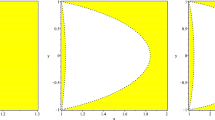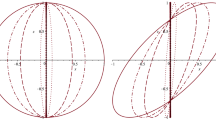Abstract
Some predictions of Einstein’s theory of general relativity (GR) still elude observation, hence analogous systems, such as optical set-ups, have been suggested as platforms for emulating GR phenomena. GR is inherently nonlinear: for example, the curvature of space is induced by masses whose dynamics is also affected by the curved space they themselves induce. But, thus far all GR emulation experiments with optical systems have reproduced only linear dynamics. Here, we study gravitational effects with optical wavepackets under a long-range nonlocal thermal nonlinearity. This system is mathematically equivalent to the Newton–Schrödinger model proposed to describe the gravitational self-interaction of quantum wavepackets. We emulate gravitational phenomena by creating interactions between a wavepacket and the gravitational potential of a massive star, observing gravitational lensing, tidal forces and gravitational redshift and blueshift. These wavepackets interact in the curved space they themselves induce, exhibiting complex nonlinear dynamics arising from the interplay between diffraction, interference and the emulated gravitational effects.




Similar content being viewed by others
References
Einstein, A. Die Grundlage der allgemeinen Relativitätstheorie. Ann. Phys. 354, 769–822 (1916).
Unruh, W. G. Experimental black-hole evaporation? Phys. Rev. Lett. 46, 1351–1353 (1981).
Lahav, O. et al. Realization of a sonic black hole analog in a Bose–Einstein condensate. Phys. Rev. Lett. 105, 240401 (2010).
Weinfurtner, S., Tedford, E. W., Penrice, M. C. J., Unruh, W. G. & Lawrence, G. A. Measurement of stimulated Hawking emission in an analogue system. Phys. Rev. Lett. 106, 021302 (2011).
Leonhardt, U. & Piwnicki, P. Optics of nonuniformly moving media. Phys. Rev. A 60, 4301–4312 (1999).
Leonhardt, U. & Piwnicki, P. Relativistic effects of light in moving media with extremely low group velocity. Phys. Rev. Lett. 84, 822–825 (2000).
Smolyaninov, I. I. Surface plasmon toy model of a rotating black hole. New J. Phys. 5, 147 (2003).
Philbin, T. G. et al. Fiber-optical analog of the event horizon. Science 319, 1367–1370 (2008).
Narimanov, E. E. & Kildishev, A. V. Optical black hole: Broadband omnidirectional light absorber. Appl. Phys. Lett. 95, 041106 (2009).
Genov, D. A., Zhang, S. & Zhang, X. Mimicking celestial mechanics in metamaterials. Nature Phys. 5, 687–692 (2009).
Sheng, C., Liu, H., Wang, Y., Zhu, S. N. & Genov, D. A. Trapping light by mimicking gravitational lensing. Nature Photon. 7, 902–906 (2013).
Batz, S. & Peschel, U. Linear and nonlinear optics in curved space. Phys. Rev. A 78, 043821 (2008).
Schultheiss, V. H. et al. Optics in curved space. Phys. Rev. Lett. 105, 143901 (2010).
Bekenstein, R., Nemirovsky, J., Kaminer, I. & Segev, M. Shape-preserving accelerating electromagnetic wave packets in curved space. Phys. Rev. X 4, 011038 (2014).
Gorbach, A. V. & Skryabin, D. V. Light trapping in gravity-like potentials and expansion of supercontinuum spectra in photonic-crystal fibres. Nature Photon. 1, 653–657 (2007).
Batz, S. & Peschel, U. Solitons in curved space of constant curvature. Phys. Rev. A 81, 053806 (2010).
Smolyaninov, I. I. Analog of gravitational force in hyperbolic metamaterials. Phys. Rev. A 88, 033843 (2013).
Engheta, N. & Ziolkowski, R. W. Metamaterials: Physics and Engineering Explorations (John Wiley, 2006).
Shalaev, V. M. Optical negative-index metamaterials. Nature Photon. 1, 41–48 (2007).
Weinberg, S. Gravitation and Cosmology: Principles and Applications of the General Theory of Relativity (John Wiley, 1972).
Jacobson, T. Thermodynamics of spacetime: The Einstein equation of state. Phys. Rev. Lett. 75, 1260–1263 (1995).
Zee, A. Einstein Gravity in a Nutshell (Princeton Univ. Press, 2013).
Dabby, F. W. & Whinnery, J. R. Thermal self focusing of lasers beams in lead glasses. Appl. Phys. Lett. 13, 284–286 (1968).
Rotschild, C., Cohen, O., Manela, O., Segev, M. & Carmon, T. Solitons in nonlinear media with an infinite range of nonlocality: First observation of coherent elliptic solitons and of vortex-ring solitons. Phys. Rev. Lett. 95, 213904 (2005).
Rotschild, C., Alfassi, B., Cohen, O. & Segev, M. Long-range interactions between optical solitons. Nature Phys. 2, 769–774 (2006).
Pertsch, T., Dannberg, P., Elflein, W., Bräuer, A. & Lederer, F. Optical Bloch oscillations in temperature tuned waveguide arrays. Phys. Rev. Lett. 83, 4752–4755 (1999).
Schwartz, T., Bartal, G., Fishman, S. & Segev, M. Transport and Anderson localization in disordered two-dimensional photonic lattices. Nature 446, 52–55 (2007).
Lahini, Y. et al. Anderson localization and nonlinearity in one-dimensional disordered photonic lattices. Phys. Rev. Lett. 100, 013906 (2008).
Plotnik, Y. et al. Experimental observation of optical bound states in the continuum. Phys. Rev. Lett. 107, 183901 (2011).
Rechtsman, M. C. et al. Photonic Floquet topological insulators. Nature 496, 196–200 (2013).
Penrose, R. On gravity’s role in quantum state reduction. Gen. Relativ. Gravit. 28, 581–600 (1996).
Moroz, I. M., Penrose, R. & Tod, P. Spherically-symmetric solutions of the Schrödinger–Newton equations. Class. Quantum Gravity 15, 2733–2742 (1998).
Tod, P. & Moroz, I. M. An analytical approach to the Schrödinger–Newton equations. Nonlinearity 12, 201–216 (1999).
Page, D. N. Classical and quantum decay of oscillations: Oscillating self-gravitating real scalar field solitons. Phys. Rev. D 70, 023002 (2004).
Guzmán, F. S. & Ureña-López, L. A. Evolution of the Schrödinger–Newton system for a self-gravitating scalar field. Phys. Rev. D 69, 124033 (2004).
Diósi, L. Notes on certain Newton gravity mechanisms of wavefunction localization and decoherence. J. Phys. A 40, 2989–2995 (2007).
Giulini, D. & Großardt, A. Centre-of-mass motion in multi-particle Schrödinger–Newton dynamics. New J. Phys. 16, 075005 (2014).
Bahrami, M., Großardt, A., Donadi, S. & Bassi, A. The Schrödinger–Newton equation and its foundations. New J. Phys. 16, 115007 (2014).
Diósi, L. Gravitation and quantum-mechanical localization of macro-objects. Phys. Lett. A 105, 199–202 (1984).
Einstein, A. Time, space, and gravitation. Science 51, 8–10 (1920).
Carlip, S. Is quantum gravity necessary? Class. Quantum Gravity 25, 154010 (2008).
Berry, M. V. & Balazs, N. L. Nonspreading wave packets. Am. J. Phys. 47, 264–267 (1979).
Siviloglou, G. A. & Christodoulides, D. N. Accelerating finite energy Airy beams. Opt. Lett. 32, 979–981 (2007).
Siviloglou, G. A., Broky, J., Dogariu, A. & Christodoulides, D. N. Observation of accelerating Airy beams. Phys. Rev. Lett. 99, 213901 (2007).
Baumgartl, J., Mazilu, M. & Dholakia, K. Optically mediated particle clearing using Airy wavepackets. Nature Photon. 2, 675–678 (2008).
Polynkin, P., Kolesik, M., Moloney, J. V., Siviloglou, G. A. & Christodoulides, D. N. Curved plasma channel generation using ultraintense airy beams. Science 324, 229–232 (2009).
Schley, R. et al. Loss-proof self-accelerating beams and their use in non-paraxial manipulation of particles’ trajectories. Nature Commun. 5, 5189 (2014).
Kaminer, I., Nemirovsky, J., Rechtsman, M., Bekenstein, R. & Segev, M. Self-accelerating Dirac particles and prolonging the lifetime of relativistic fermions. Nature Phys. 11, 261–267 (2015).
Bekenstein, R. & Segev, M. Self-accelerating optical beams in highly nonlocal nonlinear media. Opt. Express 19, 23706 (2011).
Alfassi, B., Rotschild, C., Manela, O., Segev, M. & Christodoulides, D. N. Boundary force effects exerted on solitons in highly nonlinear media. Opt. Lett. 32, 154–156 (2007).
Acknowledgements
We thank A. Ori for valuable discussions that considerably contributed to our work, and A. Arie and I. Dolev for letting us use their phase masks for generating the accelerating beams. R. Bekenstein gratefully acknowledges the support of the Adams Fellowship Program of the Israel Academy of Sciences and Humanities, and a fellowship from the Israel Ministry of Science and Technology. This research was also supported by the ICore Excellence centre ‘Circle of Light’ and the Binational USA-Israel Science Foundation BSF.
Author information
Authors and Affiliations
Contributions
All authors contributed significantly to this work.
Corresponding author
Ethics declarations
Competing interests
The authors declare no competing financial interests.
Supplementary information
Supplementary information
Supplementary information (PDF 870 kb)
Rights and permissions
About this article
Cite this article
Bekenstein, R., Schley, R., Mutzafi, M. et al. Optical simulations of gravitational effects in the Newton–Schrödinger system. Nature Phys 11, 872–878 (2015). https://doi.org/10.1038/nphys3451
Received:
Accepted:
Published:
Issue Date:
DOI: https://doi.org/10.1038/nphys3451
- Springer Nature Limited
This article is cited by
-
Hyperbolic matter in electrical circuits with tunable complex phases
Nature Communications (2023)
-
Asymmetric impact of higher order diffraction on narrow beam dynamics in nonlocal nonlinear media
Applied Physics B (2023)
-
Schrödinger–Poisson systems under gradient fields
Scientific Reports (2022)
-
Observation of branched flow of light
Nature (2020)
-
Quantum metasurfaces with atom arrays
Nature Physics (2020)





